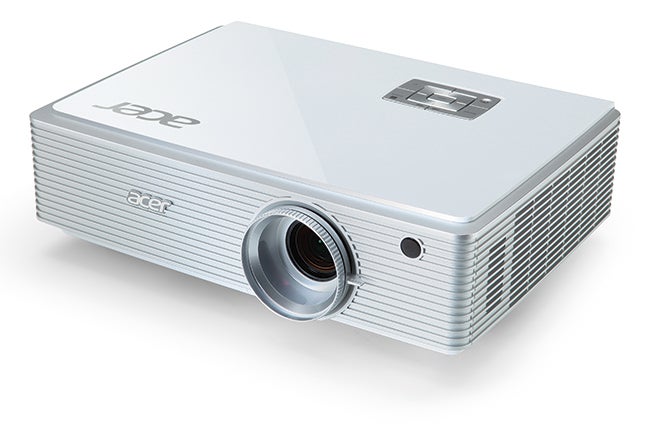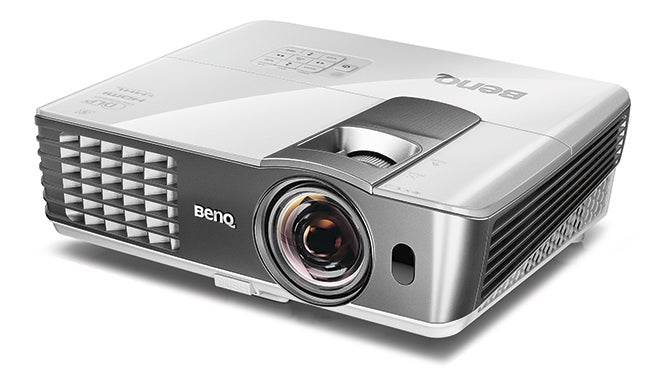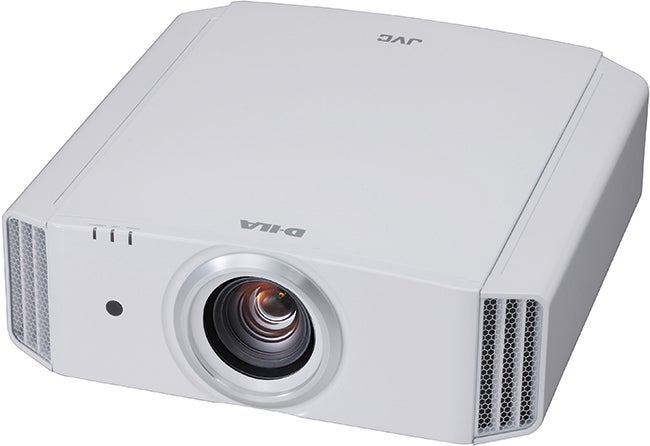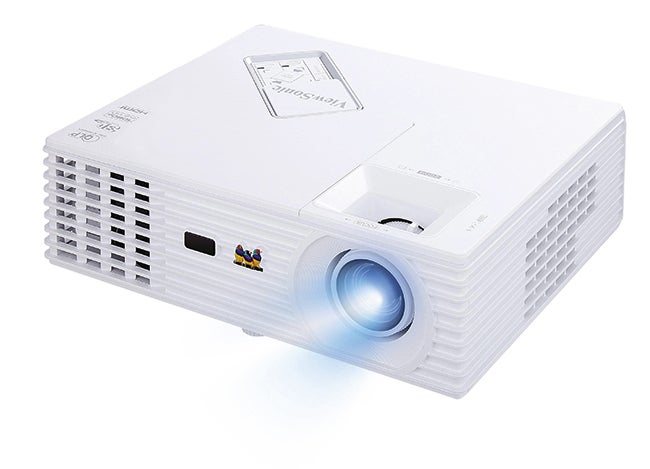We round up five digital projectors suitable to display your photographs and then pit them against each other to find out which one is best.
Digital projectors – round up
Acer K750
Website: www.acer.co.uk
Summary: The Acer boasts a huge lamp life, but its pictures aren’t perfect
The ACER K750 is the first mainstream projector with a hybrid optical system that combines a DLP-style optical system with LED (rather than the usual UHP) lights for red and blue, and a blue laser/phosphor disc arrangement for green. This approach should improve lamp life, as well as boosting the brightness and reducing the cost of typical LED-based projection systems, without compromising user safety (reflecting the laser off the phosphor disc stops light output reaching harmful levels).
At first glance the hybrid system seems a success. Lamp life is rated at 20,000 hours versus 2,000-4,000 hours on a typical UHP projector; brightness is claimed to be 1,500 Lumens, which, while hardly exceptional by UHP standards, is extremely high for an LED solution; and at £920 the price is competitive.
Photographs look good on the K750 – sharpness and detailing are both exceptional, image contrast is surprisingly good for a projector with a laser element and the colour striping associated with DLP technology is fairly well suppressed. The K750’s use of a fairly long-throw lens could limit image size in some locations, and the projector tends to infuse pictures with large amounts of green if you try to run it as brightly as you want to if there’s any ambient light in the room.
Specification
Resolution: 1,920×1,080 pixels
Projector type: Hybrid LED/laser/DLP
Claimed brightness: 1,500 Lumens
Claimed contrast: 100,000:1
Key connections: D-Sub PC port, two HDMIs, S-video, component video, RS232 control
Weight: 4kg
Dimensions: 321x231x87mm
BenQ W1080ST+
Website: www.benq.co.uk
Summary: Exceptionally easy to set up, the BenQ is a good performer
The ‘ST’ in the Ben Q W1080ST+’s name stands for ‘short throw’, as it can deliver big images even when very close to a wall or screen. With it you can enjoy your photographs at 100in across from a throw distance of just 1.5m. This is potentially a great help to photographers or clubs looking for a projector to take to multiple venues, as it needs so little space to work in. There’s also a small (1.2x) zoom to play with and you can even add a wireless video connection system for £250.
There’s no vertical image shifting, but the W1080ST+ does offer plenty of picture-calibration options, including full-colour management. It also offers a well-balanced combination of 2,200 Lumens of brightness and a 10,000:1 claimed contrast ratio that contributes to a strong all-round performance.
Particularly welcome after the Acer K750 is the impressive combination of dynamism and naturalism in its colours. The W1080ST+’s full HD pixel count also helps it deliver photographs crisply and cleanly without pixelation, and pictures are bright enough to enjoy in at least a little ambient light. The W1080ST+ isn’t perfect. Dark photographs can look slightly grey where they should look black, and you can occasionally see DLP’s colour striping. But overall this affordable projector’s pros far outweigh its cons.
Specification
Resolution: 1,920×1,080 pixels
Projector type: DLP
Claimed brightness: 2,200 Lumens
Claimed contrast: 10,000:1
Key connections: D-Sub PC port, two HDMIs, component video, RS232, 12V trigger port
Weight: 2.85kg
Dimensions: 312×244 x104mm
Epson EH-TW570
Website: www.epson.co.uk
Summary: This Epson is inexpensive, but its picture quality is weak
The LCD Epson EH-TW570 has two key attractions. First, it’s not expensive, costing just £450 from some online outlets. Second, it’s really bright. Its claimed 3,000 Lumens should enable it to produce images that still look punchy even in fairly bright rooms, so is ideal for shows in village halls and daytime living rooms.
The TW570 is extremely easy to set up too, thanks in particular to a nifty keystone correction ‘slider’ above the lens that quickly helps you get the edges of your photos straight even in strangely shaped rooms. There’s a 1.2x zoom and its connections handily include a USB port as well as a single HDMI.
However, the TW570’s resolution is only 1,280×800 pixels rather than full HD, and it doesn’t sport many colour-management options. Its biggest problem, though, is its weak picture quality. Dark areas of photos look washed out and greyed over, while colours are wan, cartoonish and unrealistic. There can be a distracting glow around bright image elements, and quietly spoken folk should note that the TW570’s fans make quite a racket.
If money’s tight and you anticipate mostly using your projector in a light room, then the TW570’s high brightness means it’s not without appeal. But if your main motivation is seeing your photographs looking as good as possible, look elsewhere.
Specification
Resolution: 1,280×800 pixels
Projector type: LCD
Claimed brightness: 3,000 Lumens
Claimed contrast: 15,000:1
Key connections: D-Sub PC port, one HDMI, USB input, S-video input
Weight: 2.4kg
Dimensions: 297x234x77mm
JVC DLA-X500R
Website: www.jvc.co.uk
Summary: The X500R is big, bulky, expensive — and utterly brilliant
The bad news first: as well as being too big to be portable, the JVC DLA-X500R is also much more expensive than any other projector here. But there’s good reason to include it.
The thing is, some photographers or camera clubs want a projector for permanent installation in a dedicated darkened room – especially given that this invariably results in the best picture quality. And no installed projector delivers on this picture-quality promise better than the X500R.
The contrast from its proprietary D-ILA optical system is enormous, with a claimed 600,000:1 contrast ratio helping dark parts of your photographs look vastly more rich, natural and detailed than they do on any portable projector. Colours are vibrant, beautifully balanced and nuanced, while e-shift 4K technology uses two slightly offset full HD imaging devices to produce pictures with 4K levels of pixel density, intense detailing and no visible pixel structure.
The X500R’s pictures aren’t as bright (1,300 Lumens maximum) as those of the other projectors here, hence the need for a darkened room. But if you can overcome that practical hurdle and can afford the stiff cost of entry, this JVC can make your photographs look so good it feels as though you’re seeing them for the very first time.
Specification
Resolution: 1,920×1,080 pixels (e-shifted to pseudo 4K)
Projector type: D-ILA
Claimed brightness: 1,300 Lumens
Claimed contrast: 600,000:1
Key connections: Two HDMIs, RS-232C, LAN port, 12V trigger
Weight: 14.7kg
Dimensions: 455x472x179mm
ViewSonic PJD7822HDL
Website: www.viewsonic.co.uk
Summary: Great value, but the ViewSonic suffers from picture striping
There’s much to like about the ViewSonic PJD7822HDL. For starters, it’s inexpensive and immensely bright, claiming a huge 3,200 Lumens that should do well even in high levels of ambient light. Its DLP engine partners that with a contrast ratio of 15,000:1, raising hopes of decent colours and black tones.
The PJD7822HDL enjoys a full HD resolution too, while its connections include two HDMIs and, unusually, support for the MHL mobile phone connection platform, and a powered USB port to handle wireless HDMI video systems like Google Chromecast.
The projector has plenty of set-up flexibility too, and claims a wider colour range thanks to a new SuperColor DLP system. Its colours really are startlingly punchy, and the lamp’s intense brightness ensures that the projector lives up to its promise of watchable results even in bright rooms. Photographs look pin-sharp and full of detail, and dark parts of the picture don’t look greyed over and washed out.
However, there are two caveats. First, the PJD7822HDL can’t accept remote-control signals from behind, which is daft, considering it’s got a short-throw lens. Second, it suffers from DLP colour striping, especially with dark photos.
Still, overall if the BenQ W1080ST+ isn’t bright enough for you, this ViewSonic is worth a try.
Specification
Resolution: 1,920×1,080 pixels
Projector type: DLP
Claimed brightness: 3,200 Lumens
Claimed contrast: 15,000:1
Key connections: Two HDMIs, powered USB, RS-232, S-Video port
Weight: 2.1kg
Dimensions: 268x221x84.4mm
Verdict – which is the best digital project for displaying photographs?
While all five digital projectors tested here can do a very respectable job of enlarging your photographs to wall-filling proportions, it’s still easy to organise them into a fairly clear-cut league table.
The Epson EH-TW570 is the least effective model. Yes, it’s bright, inexpensive and easy to set up, but it also fails to deliver much contrast to accompany the brightness, leaving images looking unnatural and unbalanced. Overall, it feels more like a business presentation projector than a photographic display.
A step up from the TW570 is Acer’s K750. Not having to worry about this model’s lamp dying for 20,000 hours is a boon for heavy users, and Acer’s projector handles darker shots nicely. But its use of a laser element to deliver green leads to some serious colour problems if you ask it to show anything bright – a problem if there’s ambient light around.
The first projector in this group test you’d probably want to consider buying is ViewSonic’s PJD7822HDL. Its innovative colour technology and high brightness lead to some colour striping with high-contrast photographs, but while this may distract some viewers, the projector’s ability to deliver richly coloured, dynamic images even in bright rooms remains eye-catchingly impressive for such an affordable model.
If money’s no object and you’re looking for a projector to install permanently in a ‘serious’ projection room, the JVC X500R is deliriously good. Photographs look simply majestic on this high-end, movie-friendly machine, with peerless contrast, bold and subtly nuanced colours, and levels of detail beyond anything its rivals can manage. While the X500R is in a class of its own in performance terms, though, its hefty cost and bulk limit its market too much for it to win this group test.
Which leaves BenQ clambering onto the winner’s podium. Its W1080ST+ treads a near-ideal line between price, features, flexibility and performance, making it great value and a cracking all-rounder when it comes to handling different venues and types of image content.
Need more help choosing? See our guide to buying a digital projector









